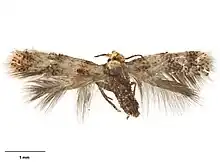| Stigmella ogygia | |
|---|---|
 | |
| Scientific classification | |
| Domain: | Eukaryota |
| Kingdom: | Animalia |
| Phylum: | Arthropoda |
| Class: | Insecta |
| Order: | Lepidoptera |
| Family: | Nepticulidae |
| Genus: | Stigmella |
| Species: | S. ogygia |
| Binomial name | |
| Stigmella ogygia (Meyrick, 1889) | |
| Synonyms | |
| |
Stigmella ogygia is a moth of the family Nepticulidae. It is found in New Zealand.
Taxonomy
This species was first described by Edward Meyrick in 1889. Morris N. Watt went on to give detailed information about the description and life cycle of this moth in 1921.[1]
Description
The length of the forewings is about 3 mm.[2] Adults have been recorded in March, July and from September to December. Reared specimens hatched in January, April, May and August. There are probably continuous generations throughout the year.
Host species
The larvae feed mainly on Senecio species, like Senecio biserratus and Senecio minimus.[3] They mine the leaves of their host plant. The mine is narrow, serpentine and close to the upper epidermal layer, widening terminally. The frass is deposited medially. Larva have been recorded from April to September and in November and December. They are 3–4 mm long and pale green.
The cocoon is made of brown silk and is located against the stem of the food plant.
References
- ↑ Morris N. Watt (1921). "The Leaf-mining Insects of New Zealand: Part II". Transactions and Proceedings of the New Zealand Institute. 53: 200–207. ISSN 1176-6158. Wikidata Q122940161.
- ↑ Hans Donner; Christopher Wilkinson (28 April 1989). "Nepticulidae (Insecta: Lepidoptera)" (PDF). Fauna of New Zealand. Department of Scientific and Industrial Research. 16: 29–31. doi:10.7931/J2/FNZ.16. ISSN 0111-5383. OCLC 924829916. Wikidata Q45079930. Archived from the original (PDF) on 26 July 2021.
- ↑ "PlantSynz - Invertebrate herbivore biodiversity assessment tool: Database". plant-synz.landcareresearch.co.nz. Retrieved 2018-07-12.